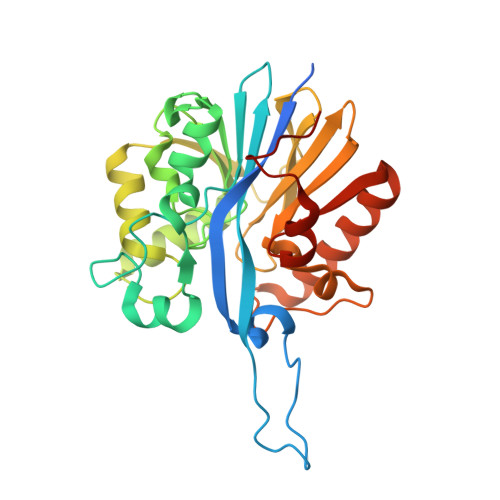Catalytic Redundancies and Conformational Plasticity Drives Selectivity and Promiscuity in Quorum Quenching Lactonases.
Corbella, M., Bravo, J., Demkiv, A.O., Calixto, A.R., Sompiyachoke, K., Bergonzi, C., Brownless, A.R., Elias, M.H., Kamerlin, S.C.L.(2024) JACS Au 4: 3519-3536
- PubMed: 39328773
- DOI: https://doi.org/10.1021/jacsau.4c00404
- Primary Citation of Related Structures:
9AYT, 9B2I, 9B2J, 9B2L, 9B2N, 9B2O, 9B2P - PubMed Abstract:
Several enzymes from the metallo-¦Â-lactamase-like family of lactonases (MLLs) degrade N- acyl L-homoserine lactones (AHLs). They play a role in a microbial communication system known as quorum sensing, which contributes to pathogenicity and biofilm formation. Designing quorum quenching ( QQ ) enzymes that can interfere with this communication allows them to be used in a range of industrial and biomedical applications. However, tailoring these enzymes for specific communication signals requires a thorough understanding of their mechanisms and the physicochemical properties that determine their substrate specificities. We present here a detailed biochemical, computational, and structural study of GcL, which is a highly proficient and thermostable MLL with broad substrate specificity. We show that GcL not only accepts a broad range of substrates but also hydrolyzes these substrates through at least two different mechanisms. Further, the preferred mechanism appears to depend on both the substrate structure and/or the nature of the residues lining the active site. We demonstrate that other lactonases, such as AiiA and AaL, show similar mechanistic promiscuity, suggesting that this is a shared feature among MLLs. Mechanistic promiscuity has been seen previously in the lactonase/paraoxonase PON1, as well as with protein tyrosine phosphatases that operate via a dual general acid mechanism. The apparent prevalence of this phenomenon is significant from both a biochemical and protein engineering perspective: in addition to optimizing for specific substrates, it may be possible to optimize for specific mechanisms, opening new doors not just for the design of novel quorum quenching enzymes but also of other mechanistically promiscuous enzymes.
Organizational Affiliation:
Departament de Qu¨ªmica Inorg¨¤nica (Seei¨® de Qu¨ªmica Org¨¤nica) & Institut de Qu¨ªmica Te¨°rica i Computacional (IQTCUB), Universitat de Barcelona, Mart¨ªi Franqu¨¨s 1, 08028 Barcelona, Spain.




















